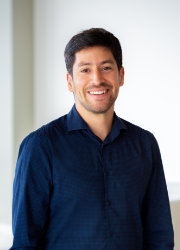Three new research groups at the BMC
With Lena Burbulla, Silvia Cappello and Rodrigo Villaseñor, the BMC welcomed three new research group leaders in the last months. "The new colleagues, with their research interests in neurodegeneration, neurogenesis and chromatin biology, are a great asset to the BMC," said BMC’s Acting Chair Peter Becker. "We are thrilled that we were able to win them over and look forward to working with them and to many fruitful collaborations."
 Neuroscientist Lena Burbulla and her team are investigating the molecular causes of neurodegenerative diseases. Her focus is on Parkinson's disease and related disorders. Parkinson's disease is the second most common neurodegenerative disease worldwide. Patients suffer from disorders of the musculoskeletal system with symptoms such as muscle tremors, muscle rigidity or slowed movements. The symptoms are triggered by a lack of the neurotransmitter dopamine in the brain. This lack is due to the death of dopamine-producing cells in a specific region of the brain, the substantia nigra. Although this connection has been known for a long time, it is still unclear why the cells in the substantia nigra die. Lena Burbulla wants to get to the bottom of this question. She is investigating the metabolism of dopamine, which can exist in various chemical forms. During her time as a postdoc at the Northwestern University, Feinberg School of Medicine, in Chicago, she was already able to show that certain forms of dopamine have a damaging effect on human nerve cells and trigger degenerative processes. She will now follow up on this work at the BMC in the Division of Metabolic Biochemistry, where she is establishing her own research group.
Neuroscientist Lena Burbulla and her team are investigating the molecular causes of neurodegenerative diseases. Her focus is on Parkinson's disease and related disorders. Parkinson's disease is the second most common neurodegenerative disease worldwide. Patients suffer from disorders of the musculoskeletal system with symptoms such as muscle tremors, muscle rigidity or slowed movements. The symptoms are triggered by a lack of the neurotransmitter dopamine in the brain. This lack is due to the death of dopamine-producing cells in a specific region of the brain, the substantia nigra. Although this connection has been known for a long time, it is still unclear why the cells in the substantia nigra die. Lena Burbulla wants to get to the bottom of this question. She is investigating the metabolism of dopamine, which can exist in various chemical forms. During her time as a postdoc at the Northwestern University, Feinberg School of Medicine, in Chicago, she was already able to show that certain forms of dopamine have a damaging effect on human nerve cells and trigger degenerative processes. She will now follow up on this work at the BMC in the Division of Metabolic Biochemistry, where she is establishing her own research group.
As a Heisenberg professor Lena Burbulla is funded by the German Research Foundation, as well as supported by one of the prestigious ERC Starting Grants of the European Research Commission. (Photo: DZNE/Frommann)
Silvia Cappello 's research interest is brain development. Together with her team, she is analyzing which mechanisms and processes control neurogenesis, i.e. the generation and development of neurons. She is gaining important insights from studying the genetic causes of congenital malformations of the brain. Such malformations affect over 1% of the population and are a major cause of developmental disorders and severe epilepsies. As a model system to study neuronal development, Silvia Cappello uses, among others, so-called cerebral organoids. Organoids are micro-tissues of a few millimeters in size grown in 3D cell cultures, which are similar to organs in some of their properties. Cerebral organoids, for example, contain different types of neurons and are similar in structure to the brain. Ultimately, Silvia Cappello wants to uncover basic mechanisms of brain development altered in brain malformations to help the development of new therapeutic approaches.
's research interest is brain development. Together with her team, she is analyzing which mechanisms and processes control neurogenesis, i.e. the generation and development of neurons. She is gaining important insights from studying the genetic causes of congenital malformations of the brain. Such malformations affect over 1% of the population and are a major cause of developmental disorders and severe epilepsies. As a model system to study neuronal development, Silvia Cappello uses, among others, so-called cerebral organoids. Organoids are micro-tissues of a few millimeters in size grown in 3D cell cultures, which are similar to organs in some of their properties. Cerebral organoids, for example, contain different types of neurons and are similar in structure to the brain. Ultimately, Silvia Cappello wants to uncover basic mechanisms of brain development altered in brain malformations to help the development of new therapeutic approaches.
Currently, Silvia’s lab is still located at the Max Planck Institute of Psychiatry in Munich and she will take a W2 professorship at the division of Physiological Genomics at the BMC in 2023. She was awarded one of the highly endowed ERC Consolidator Grants by the European Research Commission this year.
 Rodrigo Villaseñor's research focuses on the composition of chromatin. Chromatin is the packaging form of genetic information in the cell nucleus. The genetic information is stored on DNA, which can be thought of as a long string. In humans, this string is about 2m long, and cells are faced with the challenge of packaging this string to fit into the tiny space of a nucleus. To achieve this, DNA is wrapped around unique proteins called histones, resulting in a DNA-protein complex called chromatin. Histones can be chemically modified at different sites and in different ways. These modifications can be recognized and bound by other proteins in the nucleus. In this way, they have a decisive influence on the local "state" of chromatin, e.g. whether neighboring genes are active or not. Absence or wrong placement of histone modifications are associated with various diseases such as cancer. Rodrigo Villaseñor and his team are analysing which combinations of histone modifications occur at which sites in chromatin, and how they influence the state of chromatin. One focus is on the identification and characterization of novel combinations of modifications. Another focus is to develop new methods to identify and functionally study proteins that bind to specific histone modifications or combinations of modifications.
Rodrigo Villaseñor's research focuses on the composition of chromatin. Chromatin is the packaging form of genetic information in the cell nucleus. The genetic information is stored on DNA, which can be thought of as a long string. In humans, this string is about 2m long, and cells are faced with the challenge of packaging this string to fit into the tiny space of a nucleus. To achieve this, DNA is wrapped around unique proteins called histones, resulting in a DNA-protein complex called chromatin. Histones can be chemically modified at different sites and in different ways. These modifications can be recognized and bound by other proteins in the nucleus. In this way, they have a decisive influence on the local "state" of chromatin, e.g. whether neighboring genes are active or not. Absence or wrong placement of histone modifications are associated with various diseases such as cancer. Rodrigo Villaseñor and his team are analysing which combinations of histone modifications occur at which sites in chromatin, and how they influence the state of chromatin. One focus is on the identification and characterization of novel combinations of modifications. Another focus is to develop new methods to identify and functionally study proteins that bind to specific histone modifications or combinations of modifications.
Rodrigo Villaseñor has been Emmy Noether Junior Research Group Leader at the BMC since June. Funded by the German Research Foundation, he is establishing his own research group at the Division of Molecular Biology. (Photo: Johanna Saxner)

